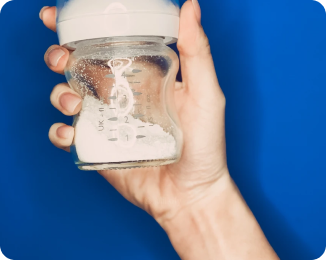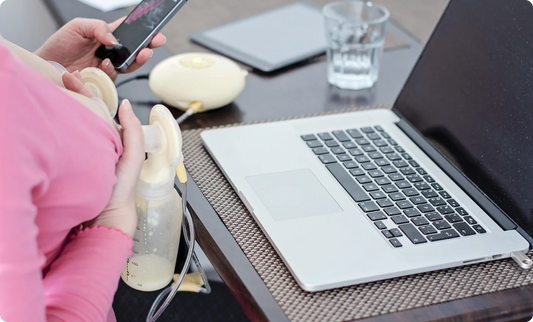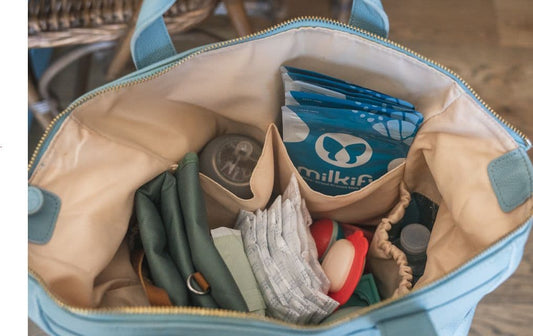
How To Use Freeze-Dried Breast Milk Powder
Berkley Luck, PhD
Freeze-drying is a new storage solution for breast milk gaining in popularity. However, due to its novelty, many mothers are faced with uncertainty around the best practices for using their breast milk powder.
If you are a nursing mother who is considering getting your breast milk freeze-dried, this post is for you!
In this post, we’ll explain why knowing how to use your freeze-dried breast milk is important, and how storage and handling requirements are different for breast milk powder and re-hydrated breast milk than they are for frozen breast milk or powdered infant formula.
What is freeze-dried breast milk, and why does it matter?
Freeze-dried breast milk is simply breast milk that has had the water removed via a process known as sublimation. Freeze-drying breast milk is the best way to store your excess breast milk - not only do you save on freezer space, but the nutrients, immune factors and probiotics in your milk are better preserved as powder.
The main concern with storage and handling of breast milk, and the reason that the CDC publishes guidelines for how to properly store and handle breast milk, is for one simple reason that often goes overlooked – breast milk is not sterile! Breast milk microbes are extremely important for helping establish your infant’s gut microbiota. Many of the bacteria in the milk are beneficial, and help provide protection against growth of pathogenic (disease-causing) bacteria. However, some bacterial species in the milk may still be harmful if allowed to grow to unsafe levels. For this reason, following the guidelines for breast milk storage and handling are important, because when followed, these guidelines can help prevent the overgrowth of harmful bacteria in your milk.
If you use a service like Milkify to freeze-dry your breast milk, one very important thing to note is that the milk will not be pasteurized. Therefore, freeze-dried breast milk is also not sterile. Pasteurization is avoided on purpose, in order to preserve the vital probiotics that are present in your milk, and which would be destroyed with pasteurization. Just as bacteria can grow in freshly expressed milk if it is left at the right temperature for extended lengths of time, the same can happen with rehydrated breast milk powder. Knowing how to properly use and store your freeze-dried breast milk powder is therefore important for the same reasons as explained above and will help maintain the safety and quality of the milk.
The following are recommendations for the safe use of freeze-dried breast milk.
How To Use Breast Milk Powder
STORAGE
1. How to store breast milk powder
BREAST MILK POWDER IN SEALED BARRIER BAGS
Breast milk powdered by Milkify is sealed in high barrier bags – one barrier bag for
each lactation bag of frozen milk that you provide. Sealed barrier bags of breast milk
powder should be stored in a cool, dry place at room temperature.
LEFTOVER BREAST MILK POWDER IN OPENED BARRIER BAG
Once the seal is broken on the barrier bags, the powder can rapidly start to attract
moisture from the air if left open. Too much moisture can cause bacterial growth. This is
important for freeze-dried breast milk because it is not pasteurized.
Out of an abundance of caution, it is therefore generally advised that you do not store
un-used powder. However, if the barrier bag zipper is re-sealed tightly right after use,
the powder should be safe to re-seal and use for a feeding later in the day. The re-
sealed bag of powder should be stored in the refrigerator, and used within 24 hours.
2. How to store re-hydrated breast milk
In general, the recommendations for rehydrated breast milk (from breast milk powder), are similar to the CDC guidelines for the handling/storage of thawed (previously frozen) breast milk.
ROOM TEMPERATURE
Rehydrated breast milk should be used within 1-2 hours if stored at room temperature.
REFRIGERATOR
Rehydrated breast milk (that baby has not started to consume) should be used within 24 hours if stored in the refrigerator.
FREEZER
Rehydrated breast milk should never be re-frozen. Freezing stops the process of
microbial growth, but cannot reverse growth that may have already occurred!
3. How to store rehydrated breast milk leftover from a feeding
Milk leftover from a feeding should be used within 2 hours after the baby is finished
feeding.
PREPARATION
1. Before preparing milk, wash your hands thoroughly with soap and warm water.
2. Add warm, purified water to bottle (add amount listed on custom label for that pouch).
3. Tear off top of bag at notches and open bag zipper.
4. Mix entire bag of powder with warm, purified water in bottle.
5. Close bottle top and swirl bottle to mix.
6. Before feeding, check that the temperature of the milk is not too hot.
# Tips and Reminders for Using Powdered Breast Milk
-
Use filtered water
You can use fluoride-free bottled filtered water, or use a reverse osmosis filter to remove
fluoride, which the American Dental Association recommends avoiding for
reconstituting infant food.
-
Do not use microwave to heat before feeding!
Microwaving can heat unevenly leading to hot spots, and cause chemicals to leach from
plastic bottles into your rehydrated breast milk. Instead, heat bottle under running hot
water, or in a pan of hot water. You can also use a kettle to heat the water before mixing,
or use a bottle warmer.
-
Do not shake, to avoid formation of bubbles
If clumps remain after mixing, gently heat the bottle under warm running water or a pan
of hot water. Anti-colic bottle nipples are also useful for helping to keep bubbles and air
in the bottle rather than in your baby's tummy.
-
Check the temperature of the rehydrated milk on the inside of your wrist, to make sure that it is not too hot before feeding to your baby
Just drop a couple dribbles from the bottle onto the inside of your wrist. If it feels cold,
warm it up a little more; if it feels hot, let it cool.
Freeze drying your breast milk can be a great way to have both the convenience of powder and the health benefits of breast milk. Knowing how to properly use your breast milk powder can ensure the quality and safety of the milk that you provide to your infant.
Read More...

Transforming the narrative around breastfeeding...
Ally Ward is a Neonatal Nurse Practitioner and mom to preemie twin boys. She has both personal and professional experience in the NICU, and is a passionate advocate for families...
Transforming the narrative around breastfeeding and work with freeze-dried breast milk
Ally Ward is a Neonatal Nurse Practitioner and mom to preemie twin boys. She has both personal and professional experience in the NICU, and is a passionate advocate for families...

Ultimate Guide to Freeze-Dried Milk for Travel
Freeze-dried breast milk is a lightweight, shelf-stable alternative to traditional storage methods, making it easier for parents to travel with their baby's nutrition. By removing water content through a specialized...
Ultimate Guide to Freeze-Dried Milk for Travel
Freeze-dried breast milk is a lightweight, shelf-stable alternative to traditional storage methods, making it easier for parents to travel with their baby's nutrition. By removing water content through a specialized...



